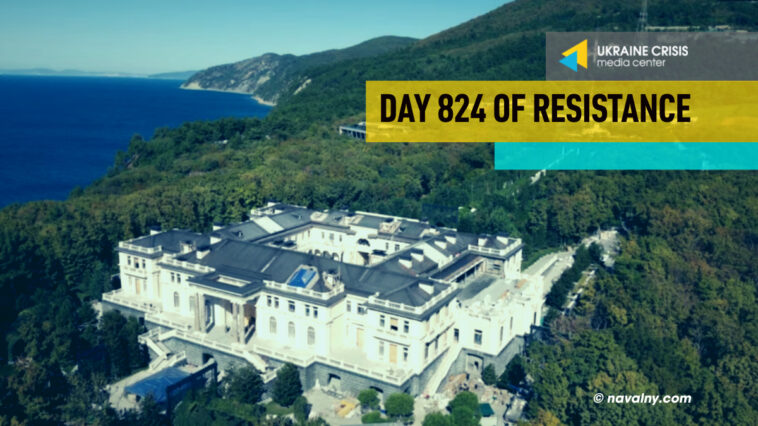Ukrainian drones strike sites close to Putin’s palace in Gelendzhik. Russia could launch a new offensive in two directions as it builds up fresh forces near the Ukraine border, according to the Institute for the Study of War. NATO countries discuss a possibility of intercepting Russian missiles over western Ukraine, Bild says.
Ukrainian drones strike sites close to Putin’s palace in Gelendzhik
Overnight on Monday, Ukrainian drones struck sites in Gelendzhik, in Russia’s Krasnodar region, not far from Putin’s palace.
“In the village of Krinitsa, debris from one of the drones damaged a house under construction. In the hamlet of Dzhankhot, a drone fell on a tree, the fire [it caused] was extinguished. According to preliminary reports, there are no casualties,” governor of the Krasnodar region, Veniamin Kondratiev said.
He added that all the drones were destroyed by Russian air defenses.
The so-called “Putin’s palace” — a residence constructed for the Russian leader, stands on Cape Idokopas, not far from the village of Dzhankhot.
The village of Krinitsa hosts the wine factory “Staryi Provence” that processes grapes from the property.
Russian Defense Ministry said that four drones had been destroyed in the Krasnodar region overnight.
Russia could launch offensive in two directions as it builds up fresh forces near Ukraine border, ISW says
Russian forces are reportedly concentrating forces of unspecified size in western Belgorod Oblast near the border with Ukraine, likely to fix and draw Ukrainian forces to the area and prepare for offensive operations that aim to expand the Russian foothold in the international border area in northeastern Ukraine, the Institute for the Study of War (ISW) said in a report on May 26.
Ukrainian President Volodymyr Zelensky stated on May 26 that Russian forces are preparing for new offensive actions and are concentrating a grouping of an unspecified size near the Ukrainian border 90 kilometers northwest of Kharkiv City.
Zelensky appears to be referring to the Grayvoron-Borisovka-Proletarskiy area in western Belgorod Oblast, and ISW has observed satellite imagery of the area that suggests that Russian forces have expanded activities at depots and warehouses in settlements in the area in recent weeks. The current size of the possible Russian force concentration in the Grayvoron-Borisovka-Proletarskiy area remains unclear, however.
Ukrainian State Border Service Representative Andrei Demchenko stated on May 26 that Russian forces may launch offensive operations into Sumy Oblast or areas of Kharkiv Oblast bordering Sumy Oblast in order to stretch and fix Ukrainian forces further along the international border area in northeastern Ukraine.
The Grayvoron-Borisovka-Proletarskiy area would notably offer Russian forces opportunities to launch offensive operations to the south in the direction of Zolochiv and Bohodukhiv, two Ukrainian towns northwest of Kharkiv City within 25 kilometers of the international border, or to the west in the direction of settlements along the P-45 highway that connects Bohodukhiv with Sumy City. Russian forces could pursue offensive operations in either one or both directions, and the Russian concentration here could be intended to cause Ukrainian forces to commit manpower and materiel to a wider section of the border in Kharkiv and Sumy oblasts.
Russian forces are also concentrating limited forces in Kursk and Bryansk oblasts close to the border with Sumy Oblast, and even limited concentrations in the areas could aim to achieve the likely desired effect of further drawing and fixing Ukrainian forces in the international border area.
Russian forces are currently bringing the Northern Grouping of Forces in the international border area up to its reported planned end strength and will likely launch only limited offensive operations along the Sumy-Kharkiv axis until the Northern Grouping of Forces is closer to its end strength.
Even limited Russian offensive operations in these areas will add pressure that stretches Ukrainian manpower and materiel along a wider front and possibly allow Russian forces to establish tactical footholds to support subsequent operations either northwest of Kharkiv City or in the direction of Sumy City. The Northern Grouping of Forces, even at the upper limit of its reported end strength, will lack the necessary manpower needed to conduct a successful operation to envelop, encircle, or seize Kharkiv or Sumy cities, however.
NATO countries discuss possibility of intercepting Russian missiles over western Ukraine, Bild says
NATO countries are discussing the possibility of shielding the skies over western Ukraine. The initiative offering “expanded air defenses” was promoted by Poland, but the final decision is yet to come, German newspaper Bild said on Monday.
Some NATO member states were ready to expand their support for Ukraine and, according to the newspaper, to conduct some of their activities directly in the country.
Estonia, the UK, Poland, Canada, Lithuania, and France agree over the need to bolster support. The U.S. and Germany are against the initiative. No decisions have been yet made. Members are discussing several areas of their possible involvement, including training of Ukrainian troops by NATO trainers inside Ukraine.
The UK, Canada and Estonia are ready to deliver weapons and ammunition not only to the Ukrainian border, but also further to the front lines. Several western countries are designing the concept of “frontline logistics,” Bild said.
How Ukrainian museums survived two years of war. Ukraine in Flames #615
In this episode of Ukraine in Flames, we discuss the remarkable resilience and evolution of Ukrainian museums amidst two years of war. Delve into Milena Chorna’s insightful reflections on internal transformations, alongside Liudmyla Mishchenko’s inspiring accounts of community-driven resilience. Moreover, uncover the challenges encountered by the Odesa National Art Museum as they navigate the forefront of decolonization efforts. Watch UIF #615 to learn more about how museums work in a country at war
Guests:
- Milena Chorna, Expert of the Working Group on the Preservation of the Cultural Heritage of Ukraine at the European Commission
- Liudmyla Mishchenko, Director of the Okhtyrka City Museum of Local Lore
- Valerii Korshunov, researcher and curator of the public programme at the Odesa National Art Museum




